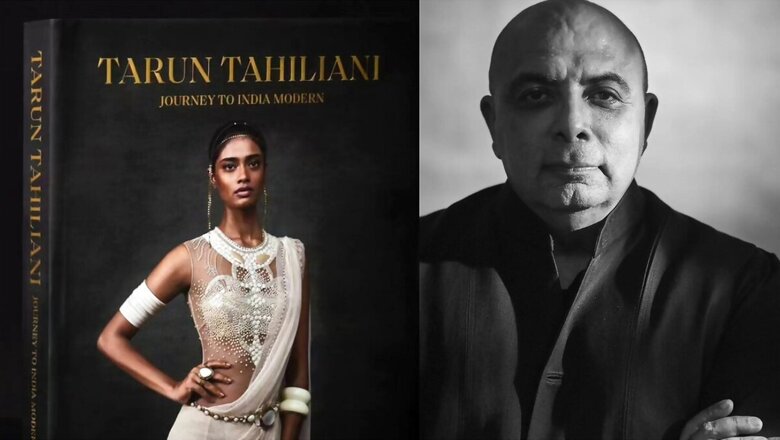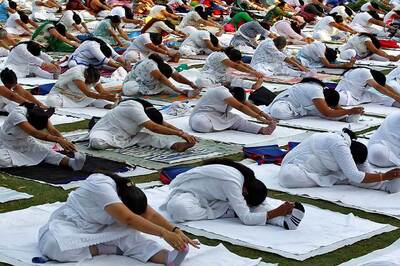
views
Tarun Tahiliani is an absolute visionary in the field of fashion and just as beautifully as he has helped weave stellar ensembles over the years, he has been able to bring forth a book that is simply delectable. Tahiliani’s ‘Journey to India Modern’ not only documents the magnificent 25 years of the couturier but also sheds light on the prowess that Indian fashion has made over the course of time. Just like the ace designer, his book too is an absolute classic- something one will regret not having laid their hands on.
In an exclusive conversation with News18 a while back at the Samsung Galaxy Tab S9 Series Jaipur Literature Festival, the brilliant designer not only spoke about his book, the inspiration behind it and all that it entails but also went into details about the ever-evolving fashion landscape of India and what lies ahead.
Your book ‘Journey To India Modern’ celebrates your spectacular journey. Could you tell us why this was the right time to document your achievements and your journey and bring it out to the world? Why was it the right time for you to publish the book when you did?
Well, you know, actually, we, just before the pandemic broke, Feb 22nd, we got locked down on March 21st. We had a party to celebrate 25 years of the studio’s existence and we invited the press from India and we took them to the studio and we showed them what we were doing and the studio’s journey and someone suggested that time and I thought it’d be nice to document something.
I didn’t know how much work it was, I might not have done it, number one, but it forced us to look at all the archives, it forced us to ask people who had photographs to send them in, and look at old pieces because we had drifted, you had drifted, the market makes you drift, you drift, times change, and then, because of the pandemic, and it was slow for that year, I had a lot of time to focus on it. So, at that time, I was doing it, you know, and my wife kept saying, please don’t make it a vanity project.
So, anyway, basically, we worked on it, and I think a friend left me a really nice message, and she said, you know, I thought this would be a book on flux. This book you’ve done is not about you, it’s about the process, and you’ve given everybody credit. And so, it was about everybody’s work. But doing it was a kind of therapy and I realized where I had drifted from the person I originally was, so it helped me navigate.
While working on the book, you went back into the archives and saw all that was documented on you and your work. But while going through the process, were there things, were there little moments of realization, where you felt you could have done it in a better way or a different way maybe?
If it was not for the book, I would not have gone through so much and in the process there were not one but many such moments. When I looked at that Milan collection, you see, if you look at my clothes, and people always tell me this, we can take out your clothes after 20 years and wear them. A, because of the quality, but because of the timelessness. I come from India. Our style was timeless.
You can take out your great-grandmother’s saree and wear it today. You cannot, if you were French, take out your great-grandmother’s gown and wear it, right? So, we are timeless.
These patterns have been timeless for 400 years. And we are trying too hard to follow the Western mould. So, I understood that. I understood timelessness. I wish I had stuck it in Italy, you know, to push that. But I was not ready. I was too young. I didn’t have the manufacturing backup. And sometimes to have a bit of regret is also a positive thing because you won’t make that mistake again. It’s consciousness. Everything is about consciousness.
And in the last 25 years, you have come with so many collections, is there a collection you wish you would not have done?
That’s a very good question because I haven’t thought about it. I think in between, there was a lot of pressure on us to become…India suddenly became over-ethnic. When you girls were wearing Western clothes, and suddenly you wanted to be Jodha Akbar. And I was pushed into that. And it’s not my look. I like one necklace. I like pastel colours. I want you women to be modern. She is wearing a nice draped top. She is wearing a nice draped top with a lehenga. The style is not separate for Indian and Western. We are one people.
And there are so many celebrities that you have worked with over the years. Going through your book and your journey who would you style differently than you did?
I have but also I do not work with that many. For me, it is most exciting when a celebrity like Lady Gaga takes it, chops it up and wears it herself. I did not even know she was wearing TT for her Big India performance. And she was sweet. She stopped the concert and said, I came with a plane full of clothes. And then I saw this. Who is Tarun Tahiliani? She announced that. It was global news. She is so sweet of heart. I have learnt a lot from these people.
Going back to your book again, how does the book capture the essence of your design evolution?
I think it is there for you to see. The fusion is there for you to see. And I have got amazing compliments. It is not fluffy, it’s not about me. And for Alia Allana, saying that what a writer. And this girl has gone and talked to our peons from 30 years back, our masterjis, everybody. No one was too small and no detail was too small before she wrote it and captured the essence of the studio.
A lot of people might think that your book is a celebration of your prowess as a designer. But you are showcasing the Indian sartorial prowess too…
And saying that these are things we are losing. India is not just about colour and embroidery, That is very nouveau. That is a new thing. My mother never, she might have had three embroidered things and she had a lot of beautiful things in her cupboard. It is about the drape. It is about colour. And it is about a fierceness that Indian women have had. You know, because, let’s face it, it is much more about women’s fashion here than it’s about men. Because men became very straight-laced and westernised to go to work. And, you know, in the corporate world, they became suits, jackets, pants. The women stayed much more Indian, you know.
How do you envision the future of Indian fashion and what aspirations do you have for its evolution?
My biggest aspiration is that instead of being Western fashion and very Indian fashion, there is going to be more of a fusion. You and I are doing this interview in English, but we are Indian, right? There may be 200 million Indians who speak English like that. That is more than Europe and England. So, I want us to evolve into a fashion centre. When I come to JLf next time, a lot more people are wearing modern Indian fashion. Not just things copied from the West. That we make our fashion practical for every day, and there is a little bit of chikan work or one motif that shows that you are Indian but modern. People are experimenting with so many textures.
And they have learnt techniques because of the design schools. So, it taught them a technique that wasn’t part of the Indian vocabulary. And fit. Today you have got a designer like Gaurav Gupta. Well, he also went to study abroad doing amazing drapes, which he’s taken to the world.
In what ways do you believe Indian fashion can leave a lasting impact on the global landscape?
It’s already started. The landscape will be lasting if we make things that the globe can wear. And don’t just stay a factory for them to do their work.
















Comments
0 comment